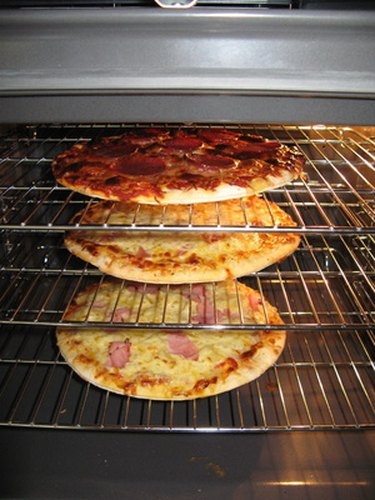
If you're not using your convection oven, or the convection setting on a standard oven, you're missing out. In a convection oven, food is cooked by hot air that is circulated by fans instead of by radiant heat like a standard oven uses. You won't notice a difference in the flavors of foods cooked in a convection oven versus in a standard oven, but a convection oven cooks food more evenly and more quickly – using less energy – than a standard oven does. This is one case in which blowing a lot of hot air is a good thing.
Step 1
Prepare food for cooking. Pick baking dishes with low sides to allow the air to circulate freely over the food. Stick your pans in the oven before putting food in them to check they'll fit; any pan you use should have two inches of free space between it and any oven wall. Use a dark, dull aluminum or steel pan if you're cooking something that you want well browned; pick shiny pans for less browning. You may also use glass dishes if you wish.
Video of the Day
Step 2
Arrange the racks in the oven so that each pan will have at least two inches of clearance between it and the pan above or below it. If you're only cooking one pan of food, place the rack in the center of the oven.
Step 3
Heat the oven to the temperature prescribed in your chosen recipe. Follow your oven's instruction manual if you're unsure how to use its convection setting.
Step 4
Place the pan in the oven once the oven is done preheating. Leave the pan uncovered. Using a lid or even placing foil on top will prevent the hot air from reaching the food.
Step 5
Set a timer for 25 percent less time than your recipe calls for. Some cooking experts recommend either reducing the oven temperature or the cooking time, but reducing both is a smart idea when you're getting the hang of cooking in a convection oven.
Step 6
Check the food for doneness when the timer goes off. Use an instant-read meat thermometer to check meat; according to the U.S. Department of Agriculture, poultry needs to have an internal temperature of at least 165 degrees Fahrenheit, ground meats need to be cooked to at least 160 degrees and other meats need to be 145 degrees in order to be safe. Keep in mind, however, that meat continues to cook after it's removed from the oven, a principle called "residual" or "carryover cooking." Small roasts or chickens can increase as much as 5 to 10 degrees in the 15 minutes after you remove them from heat; for best results, remove them a little early, tent them with foil and continue checking the food every minute or two until they reach the proper temperature.
Step 7
Write a note on the recipe you used, recording the exact time it took for the dish to be fully cooked using the convection setting. These notes will help you time things perfectly the next time around.
Tip
The “25 rule” is standard for adjusting any recipe designed for a conventional oven, and remembering it will help you made adjustments easily. Just reduce heat and cooking time by 25 degrees and 25 percent, respectively. For instance, if you have a non-convection recipe that calls for baking at 375 degrees for 20 minutes, heat the oven to 350 degrees and set a timer for 15 minutes.
Warning
While most foods will cook just fine in a convection oven, some delicate items aren't right for this method. Don't cook cakes, souffles, quick breads or anything else that uses a light, moist batter. The fans will blow the batter around, causing splatters and burns inside your oven.
Video of the Day